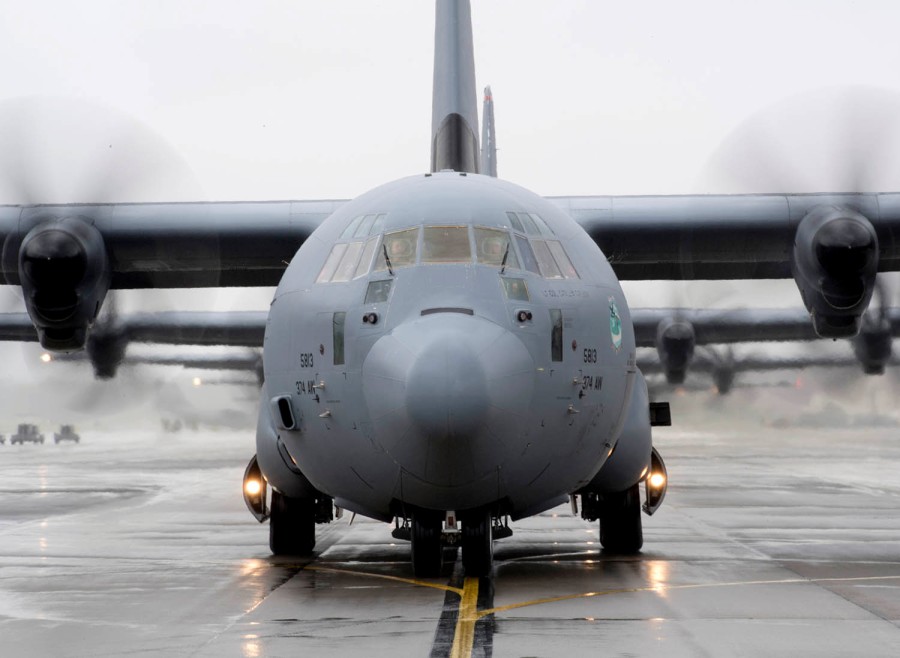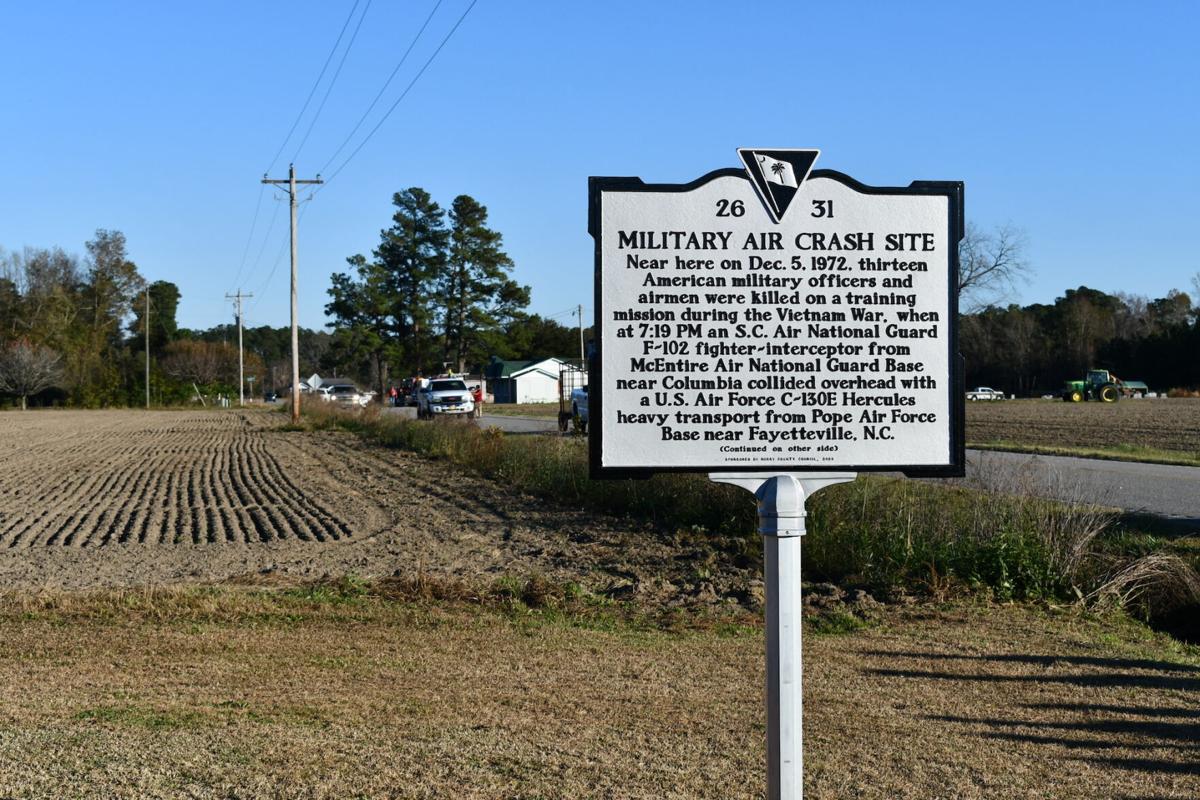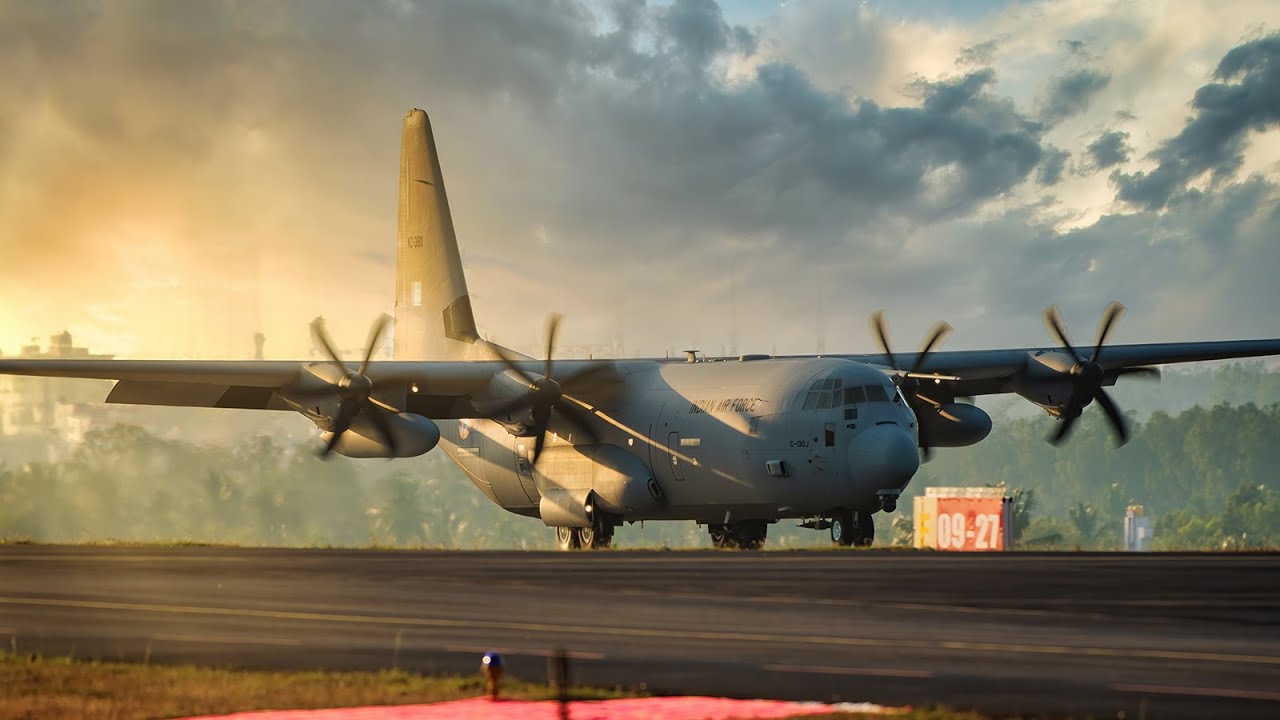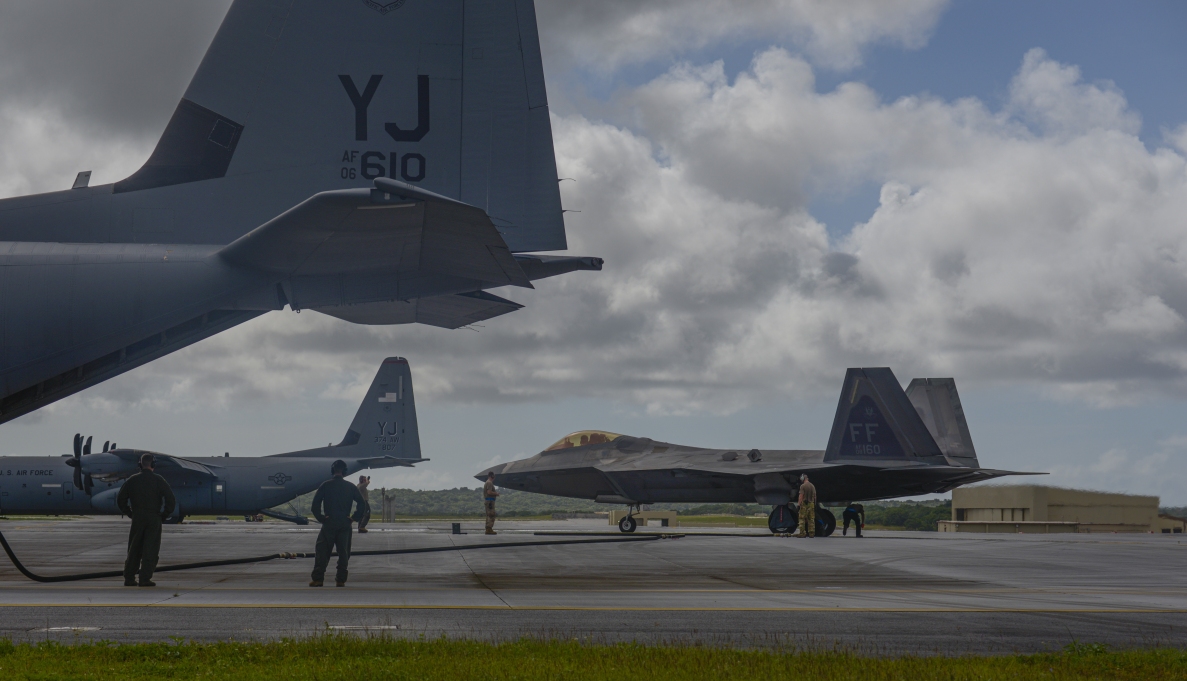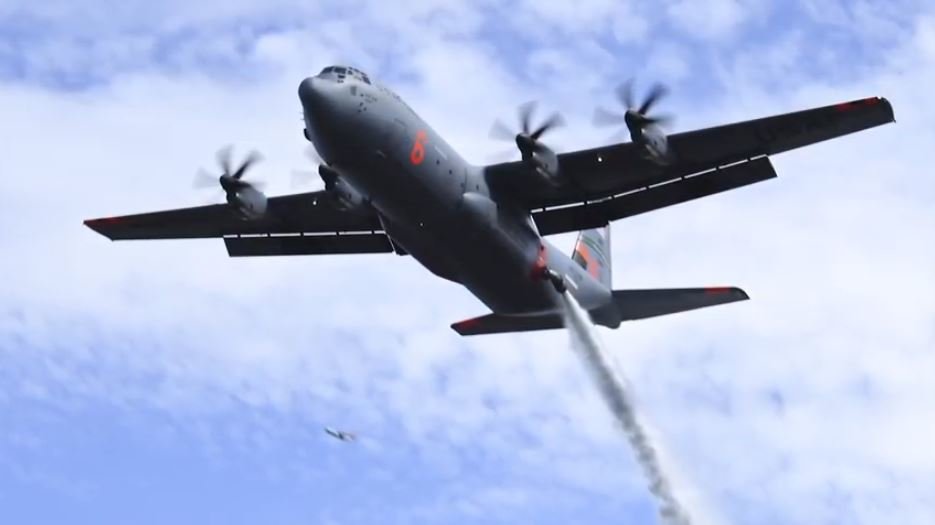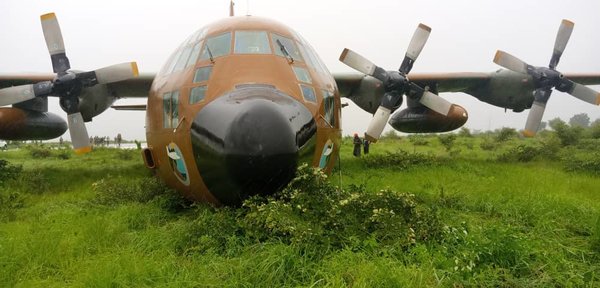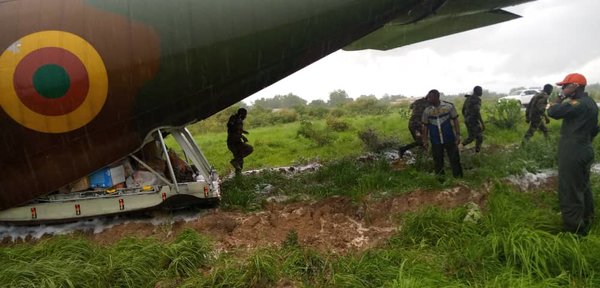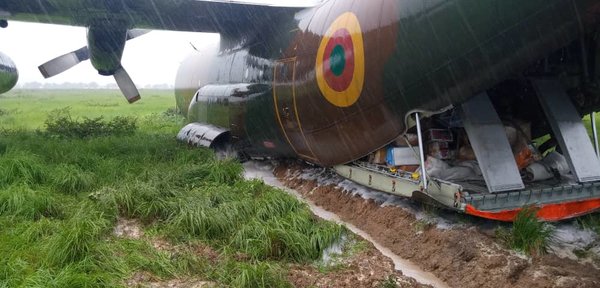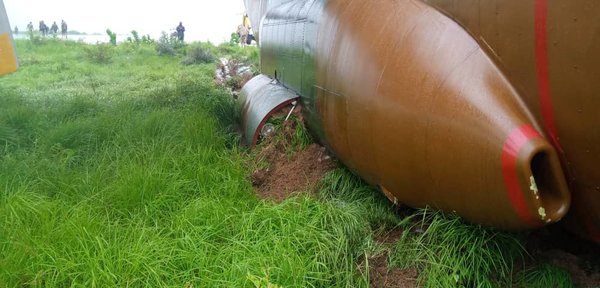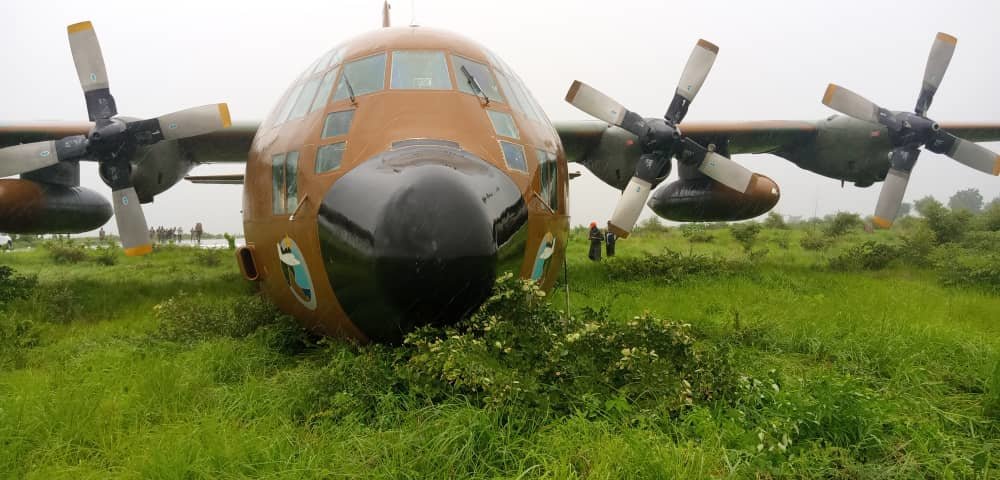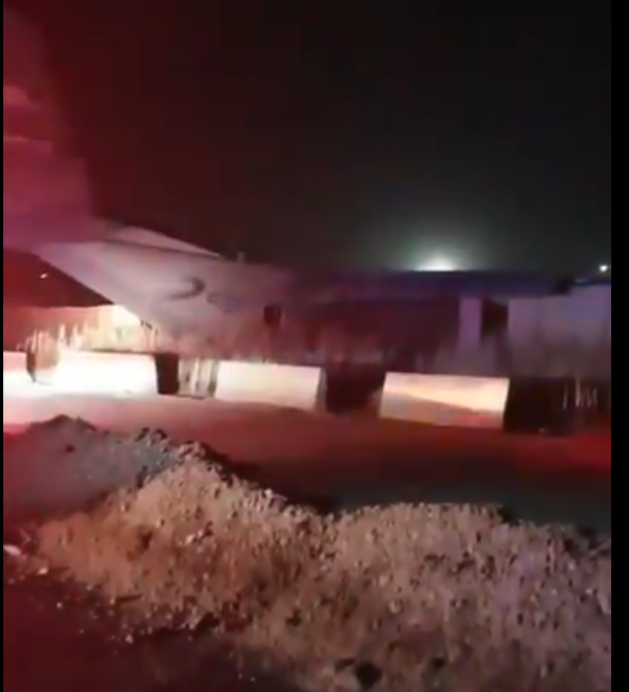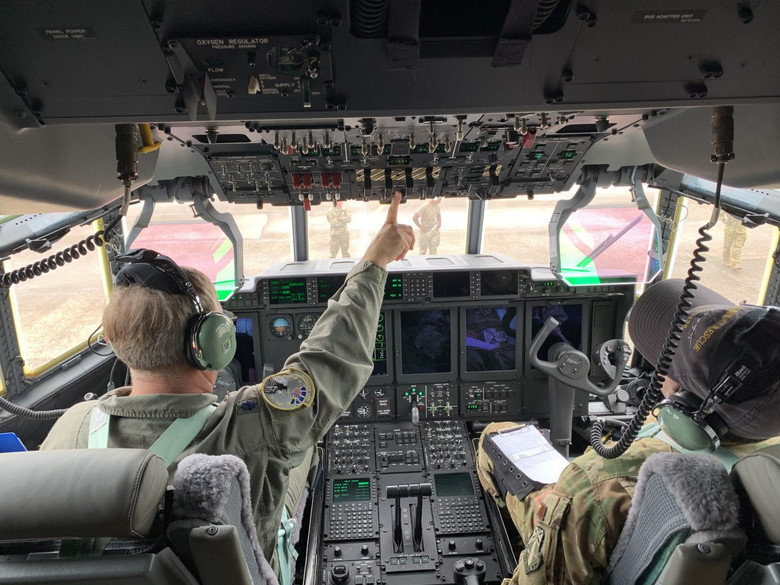-
Posts
148 -
Joined
-
Last visited
-
Days Won
6
Content Type
Profiles
Forums
Store
Gallery
Downloads
Calendar
C-130 Hercules News
Everything posted by casey
-
Social distancing, mask wearing, contact tracing, testing and quarantines have enabled the U.S. military’s airlift hub in Tokyo to continue its mission across the Indo-Pacific region despite the global pandemic, the 374th Airlift Wing commander said Friday. “We’ve been executing every mission we’ve been tasked to do, not without regard for COVID, but despite COVID,” Col. Andrew Campbell told Stars and Stripes in an interview. COVID-19 is the respiratory disease caused by the coronavirus. The airlifters, stationed at Yokota in western Tokyo, fly 14 C-130J Super Hercules transport planes in support of the Indo-Pacific Command. The wing also operates UH-1N helicopters and C-12J transports. Their missions include tactical airdrop, aeromedical evacuation, humanitarian assistance, disaster relief, and transporting distinguished visitors. ADVERTISING “We’ve continued to move safely and with such care that we haven’t had significant COVID transmission caused by the missions that we’ve been executing,” Campbell said. Yokota, with a community of just under 12,000 airmen, civilian workers and family members, has reported at least 86 coronavirus cases since May, not counting an undisclosed number of Navy personnel who sequestered on base before shipping out with the Ronald Reagan Carrier Strike Group. In November, a small outbreak fueled by more than 30 instances of spreading by close contact contributed to a monthly total of 62 people infected with the virus, the most the base has reported in any month during the pandemic. Three C-130J Super Hercules assigned to the 36th Airlift Squadron at Yokota Air Base, Japan, fly near Mount Fuji, May 11, 2020. YASUO OSAKABE/U.S. AIR FORCE Campbell said oft-repeated health protection measures such as social distancing, contact tracing, masks for those in close contact, restriction of movement for people coming into Japan and testing have helped the Air Force contain the virus. “The public health protection measures we have in place have been very effective in enabling us to sustain our mission,” he said. “People have done a really good job of complying with the protective measures out of a sense of community.” The wing doesn’t have data on the number of Yokota personnel who have been ordered abroad this year, although Campbell said his airmen are constantly going on missions. “We are a mobility wing,” he said. “We constantly have people executing the mobility mission.” This year Yokota airmen have, for example, flown to Alaska to train, ferried soldiers to Palau and conducted refueling operations on Guam and Okinawa. “There is no debate that COVID has impacted every aspect of everything we do but the successes we have had despite this challenge are remarkable,” he said. The U.S. military’s mobility forces operate continuously and globally even during a pandemic, Campbell said. article continues below “We have continued to execute our mission despite COVID,” he said. “It’s a positive reflection on our resilience and perseverance.” Campbell said there have been tactical highlights, such as a Nov. 24 mission that involved one of the wing’s C-130Js doing a hot-pit refuel of a pair of F-22 Raptor stealth fighters at Koror Palau International Airport. The aircraft had an aerial bulk fuel delivery system designed to transport fuel rapidly to spots close to or behind enemy lines. One of the wing’s aircraft refueled Raptors the same way at Andersen Air Force Base, Guam, in September, according to an Air Force news release Nov. 24. “We did a similar operation between a C-130J and an F-15 on Okinawa recently,” Campbell said. Over the summer, Yokota personnel deployed to the Aleutian Islands of Alaska. Ahead of the mission, airmen rehabilitated a 1970s-era tactical air navigation system using parts bought at Joyful Honda, a local hardware store. They used the gear to guide aircraft transiting between Alaska and Japan, he said. It’s unclear where Yokota airmen might travel on missions next year, Campbell said. People will be watching how the global community moves over the next couple of months, “ … hopefully out from this dark cloud of COVID,” he said. “Everyone is hopeful the vaccine will enable us to return to full normality.” View original article here: Simple health precautions help keep Tokyo-based airlifters flying during the pandemic - Pacific - Stripes
-
Social distancing, mask wearing, contact tracing, testing and quarantines have enabled the U.S. military’s airlift hub in Tokyo to continue its mission across the Indo-Pacific region despite the global pandemic, the 374th Airlift Wing commander said Friday. “We’ve been executing every mission we’ve been tasked to do, not without regard for COVID, but despite COVID,” Col. Andrew Campbell told Stars and Stripes in an interview. COVID-19 is the respiratory disease caused by the coronavirus. The airlifters, stationed at Yokota in western Tokyo, fly 14 C-130J Super Hercules transport planes in support of the Indo-Pacific Command. The wing also operates UH-1N helicopters and C-12J transports. Their missions include tactical airdrop, aeromedical evacuation, humanitarian assistance, disaster relief, and transporting distinguished visitors. ADVERTISING “We’ve continued to move safely and with such care that we haven’t had significant COVID transmission caused by the missions that we’ve been executing,” Campbell said. Yokota, with a community of just under 12,000 airmen, civilian workers and family members, has reported at least 86 coronavirus cases since May, not counting an undisclosed number of Navy personnel who sequestered on base before shipping out with the Ronald Reagan Carrier Strike Group. In November, a small outbreak fueled by more than 30 instances of spreading by close contact contributed to a monthly total of 62 people infected with the virus, the most the base has reported in any month during the pandemic. Three C-130J Super Hercules assigned to the 36th Airlift Squadron at Yokota Air Base, Japan, fly near Mount Fuji, May 11, 2020. YASUO OSAKABE/U.S. AIR FORCE Campbell said oft-repeated health protection measures such as social distancing, contact tracing, masks for those in close contact, restriction of movement for people coming into Japan and testing have helped the Air Force contain the virus. “The public health protection measures we have in place have been very effective in enabling us to sustain our mission,” he said. “People have done a really good job of complying with the protective measures out of a sense of community.” The wing doesn’t have data on the number of Yokota personnel who have been ordered abroad this year, although Campbell said his airmen are constantly going on missions. “We are a mobility wing,” he said. “We constantly have people executing the mobility mission.” This year Yokota airmen have, for example, flown to Alaska to train, ferried soldiers to Palau and conducted refueling operations on Guam and Okinawa. “There is no debate that COVID has impacted every aspect of everything we do but the successes we have had despite this challenge are remarkable,” he said. The U.S. military’s mobility forces operate continuously and globally even during a pandemic, Campbell said. article continues below “We have continued to execute our mission despite COVID,” he said. “It’s a positive reflection on our resilience and perseverance.” Campbell said there have been tactical highlights, such as a Nov. 24 mission that involved one of the wing’s C-130Js doing a hot-pit refuel of a pair of F-22 Raptor stealth fighters at Koror Palau International Airport. The aircraft had an aerial bulk fuel delivery system designed to transport fuel rapidly to spots close to or behind enemy lines. One of the wing’s aircraft refueled Raptors the same way at Andersen Air Force Base, Guam, in September, according to an Air Force news release Nov. 24. “We did a similar operation between a C-130J and an F-15 on Okinawa recently,” Campbell said. Over the summer, Yokota personnel deployed to the Aleutian Islands of Alaska. Ahead of the mission, airmen rehabilitated a 1970s-era tactical air navigation system using parts bought at Joyful Honda, a local hardware store. They used the gear to guide aircraft transiting between Alaska and Japan, he said. It’s unclear where Yokota airmen might travel on missions next year, Campbell said. People will be watching how the global community moves over the next couple of months, “ … hopefully out from this dark cloud of COVID,” he said. “Everyone is hopeful the vaccine will enable us to return to full normality.” View original article here: Simple health precautions help keep Tokyo-based airlifters flying during the pandemic - Pacific - Stripes View full article
-
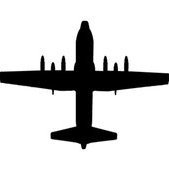
C-130 News: Military plane crash victims memorialized after 48 years
casey posted an Article in 2020 C-130 News
Horry County officials and family members of the thirteen airmen that passed away in the 1972 military air crash in the Bayboro area gathered Saturday to honor the victims on the 48th anniversary of the crash. "Historic preservation is what I like to do," said Jamie Thompkins, with Horry County Historical Preservation Society, who helped plan the event. "I had no idea this was going to be an emotional rollercoaster for me, but it has been ... What I found was a story that was tucked away in our county's history and when I opened the door, so to speak, it came rushing out." On December 5, 1972, thirteen men died when an F-102 interceptor based out of McEntire Air National Guard base near Columbia collided in mid-air with a C-130 transport plane out of what is now Pope Army Airfield in North Carolina. The aircraft crashed to the ground near the Bayboro area off Joyner Swamp Road. advertisement “The accident occurred on a night combat profile mission, referred to as a CORONET SIERRA mission, designed to test the various options and capabilities of the … aircraft,” an Air Force incident report read, noting it was a training mission. An historical roadside marker, as well as a headstone with all thirteen names was placed in the field next to the Joyner Swamp Fire Station just down the road from the crash site near Tyler Road. Horry County Councilman Al Allen, one of the driving forces behind the planning of the memorial more than a year in the making, said that the markers are on county property and assured the family that the memorials will always be taken care of properly. "I listened to the personal story of each airman, and each one of them has a special memory, and each conversation I ended up in tears. This only cemented my resolve to see this project to a positive outcome. I feel blessed to have had the opportunity to bring everyone together today for this ceremony," Thompkins said. "I am humbled to share in such precious memories." Many local, state, and military officials attended, including members of the Horry County Council, the Honorable Thomas Keegan (on behalf of Congressman Tom Rice), and Col. Joseph Vanoni with the U.S. Air Force out of Pope Army Airfield in North Carolina. The Horry County Fire Rescue Honor Guard and the Horry County Police Honor Guard were in attendance as well as the Coastal Carolina Shields, Pipes and Drums. Vanoni told the crowd he was proud to be in attendance "to honor them as we should have 48 years ago." advertisement Family members of the servicemen came from as far away as California and Illinois for the memorial, saying the event was some closure their families needed. "It was wonderful," said Kathy Fischer, sister of then 23-year-old Doug Thierer, who was on board the C-130 that crashed. Ronald Tyler and his children Greg Tyler and Phyllis Richardson, who all lived just by the site of the crash, told their story of that night, when Ronald Tyler ran out of his house with his children. After the midair collision, the remainder of the C-130 seemed to be headed straight for their home. Tyler and Richardson both told the families that while they were scared that night, they understand their experience was nothing compared to the family members that lost loved ones. "They want you to know they shared in your grief," Thompkins told the family during the memorial. Richardson told the crowd she had been blessed to have been able to meet and befriend the Thierer family. “Phyllis, she was my age at the time,” Fischer said. “I never thought about that. It gave me a different empathy. I never thought about what was going on [down] on the ground because we were so totally devastated.” Read more about the Tyler's experience that night, as well as comments from some airmen family members here. "I can't think but one thought and that is that freedom is not free. Some folks have paid a hefty toll," Thompkins said. "The absolute bravery of people I don't even know who are willing to put their lives on the line every day is pretty overwhelming. They should be respected by all, because this is not a debt we can repay. We can however come together as a community to tell our story to see that these men who perished here will never be forgotten, and that this spot will be marked forever for all those to see that something significant happened here." View original article here: Military plane crash victims memorialized after 48 years | News | myhorrynews.com -
Horry County officials and family members of the thirteen airmen that passed away in the 1972 military air crash in the Bayboro area gathered Saturday to honor the victims on the 48th anniversary of the crash. "Historic preservation is what I like to do," said Jamie Thompkins, with Horry County Historical Preservation Society, who helped plan the event. "I had no idea this was going to be an emotional rollercoaster for me, but it has been ... What I found was a story that was tucked away in our county's history and when I opened the door, so to speak, it came rushing out." On December 5, 1972, thirteen men died when an F-102 interceptor based out of McEntire Air National Guard base near Columbia collided in mid-air with a C-130 transport plane out of what is now Pope Army Airfield in North Carolina. The aircraft crashed to the ground near the Bayboro area off Joyner Swamp Road. advertisement “The accident occurred on a night combat profile mission, referred to as a CORONET SIERRA mission, designed to test the various options and capabilities of the … aircraft,” an Air Force incident report read, noting it was a training mission. An historical roadside marker, as well as a headstone with all thirteen names was placed in the field next to the Joyner Swamp Fire Station just down the road from the crash site near Tyler Road. Horry County Councilman Al Allen, one of the driving forces behind the planning of the memorial more than a year in the making, said that the markers are on county property and assured the family that the memorials will always be taken care of properly. "I listened to the personal story of each airman, and each one of them has a special memory, and each conversation I ended up in tears. This only cemented my resolve to see this project to a positive outcome. I feel blessed to have had the opportunity to bring everyone together today for this ceremony," Thompkins said. "I am humbled to share in such precious memories." Many local, state, and military officials attended, including members of the Horry County Council, the Honorable Thomas Keegan (on behalf of Congressman Tom Rice), and Col. Joseph Vanoni with the U.S. Air Force out of Pope Army Airfield in North Carolina. The Horry County Fire Rescue Honor Guard and the Horry County Police Honor Guard were in attendance as well as the Coastal Carolina Shields, Pipes and Drums. Vanoni told the crowd he was proud to be in attendance "to honor them as we should have 48 years ago." advertisement Family members of the servicemen came from as far away as California and Illinois for the memorial, saying the event was some closure their families needed. "It was wonderful," said Kathy Fischer, sister of then 23-year-old Doug Thierer, who was on board the C-130 that crashed. Ronald Tyler and his children Greg Tyler and Phyllis Richardson, who all lived just by the site of the crash, told their story of that night, when Ronald Tyler ran out of his house with his children. After the midair collision, the remainder of the C-130 seemed to be headed straight for their home. Tyler and Richardson both told the families that while they were scared that night, they understand their experience was nothing compared to the family members that lost loved ones. "They want you to know they shared in your grief," Thompkins told the family during the memorial. Richardson told the crowd she had been blessed to have been able to meet and befriend the Thierer family. “Phyllis, she was my age at the time,” Fischer said. “I never thought about that. It gave me a different empathy. I never thought about what was going on [down] on the ground because we were so totally devastated.” Read more about the Tyler's experience that night, as well as comments from some airmen family members here. "I can't think but one thought and that is that freedom is not free. Some folks have paid a hefty toll," Thompkins said. "The absolute bravery of people I don't even know who are willing to put their lives on the line every day is pretty overwhelming. They should be respected by all, because this is not a debt we can repay. We can however come together as a community to tell our story to see that these men who perished here will never be forgotten, and that this spot will be marked forever for all those to see that something significant happened here." View original article here: Military plane crash victims memorialized after 48 years | News | myhorrynews.com View full article
-
The US has approved the sale of USD 90 million worth of military hardware and services in support of its fleet of C-130J Super Hercules military transport aircraft. This proposed sale will support the foreign policy and national security of the United States by helping to strengthen the US-Indian strategic relationship and improve the security of a “Major Defense Partner”, the Defense Security Cooperation Agency (DSCA) of the Department of Defense said on Thursday. In a major sales notification to Congress, DSCA said that India continues to be an important force for political stability, peace and economic progress in the Indo-Pacific and South Asia region. Among the requests made by India include aircraft consumables spares and repair/return parts; Cartridge Actuated Devices/Propellant Actuated Devices (CAD/PAD) fire extinguisher cartridges; flare cartridges; Advanced Radar Warning Receiver shipset; 10 Lightweight Night Vision Binocular; 10 AN/AVS-9 Night Vision Goggle; GPS; Electronic Warfare; instruments and lab equipment support. The estimated total amount is USD 90 million. The Pentagon said that the proposed sale ensures the previously procured aircraft operates effectively to serve the needs of the Indian Air Force (IAF), the Army and the Navy transport requirements, local and international humanitarian assistance, and regional disaster relief. This sale of spares and services will enable the IAF to sustain a mission-ready status with respect to the C-130J transport. India will have no difficulty absorbing this additional sustainment support, it said. According to the Pentagon, the proposed sale of this equipment and support will not alter the basic military balance in the region. The prime contractor will be Lockheed-Martin Company, Marietta, Georgia. In a major move in 2016, the US had designated India a "Major Defence Partner" intending to elevate defence trade and technology sharing to a level commensurate with that of its closest allies and partners. View Original article here: US approves sale of USD 90 mn worth of military equipment and services to India (outlookindia.com)
-
The US has approved the sale of USD 90 million worth of military hardware and services in support of its fleet of C-130J Super Hercules military transport aircraft. This proposed sale will support the foreign policy and national security of the United States by helping to strengthen the US-Indian strategic relationship and improve the security of a “Major Defense Partner”, the Defense Security Cooperation Agency (DSCA) of the Department of Defense said on Thursday. In a major sales notification to Congress, DSCA said that India continues to be an important force for political stability, peace and economic progress in the Indo-Pacific and South Asia region. Among the requests made by India include aircraft consumables spares and repair/return parts; Cartridge Actuated Devices/Propellant Actuated Devices (CAD/PAD) fire extinguisher cartridges; flare cartridges; Advanced Radar Warning Receiver shipset; 10 Lightweight Night Vision Binocular; 10 AN/AVS-9 Night Vision Goggle; GPS; Electronic Warfare; instruments and lab equipment support. The estimated total amount is USD 90 million. The Pentagon said that the proposed sale ensures the previously procured aircraft operates effectively to serve the needs of the Indian Air Force (IAF), the Army and the Navy transport requirements, local and international humanitarian assistance, and regional disaster relief. This sale of spares and services will enable the IAF to sustain a mission-ready status with respect to the C-130J transport. India will have no difficulty absorbing this additional sustainment support, it said. According to the Pentagon, the proposed sale of this equipment and support will not alter the basic military balance in the region. The prime contractor will be Lockheed-Martin Company, Marietta, Georgia. In a major move in 2016, the US had designated India a "Major Defence Partner" intending to elevate defence trade and technology sharing to a level commensurate with that of its closest allies and partners. View Original article here: US approves sale of USD 90 mn worth of military equipment and services to India (outlookindia.com) View full article
-

C-130 News: C-130J refuels F-22s using Aerial Bulk Fuel Delivery System
casey posted an Article in 2020 C-130 News
A C-130J Super Hercules conducted a hot-pit refuel of a pair of F-22 Raptors Nov. 24 at Koror Palau International Airport using an Aerial Bulk Fuel Delivery System. This mission was one of a series of operations associated with Westpac, a dynamic force employment of the 94th Expeditionary Fighter Squadron to the U.S. Indo-Pacific Command’s area of responsibility. According to the Air Expeditionary Force Fuels Management Pocket Guide, ABFDS is an aerial, fuels-delivery system that enables aircraft to transport fuel rapidly to locations close to or behind enemy lines. This system is normally installed on C-130s but can be used on C-5 Galaxies and C-17 Globemaster IIIs. “Hot-pit refueling operations using ABFDS are relatively new,” said Chief Master Sgt. Steve McClure, Pacific Air Forces command fuels functional manager. “The primary design of the ABFDS system is to refuel or to take bulk fuel to bladders in a contingency location. It has the capability to refuel aircraft and always has, but we’ve stepped that up with (agile combat employment).” According to McClure, the 374th Airlift Wing developed the checklist to use ABFDS to refuel other aircraft, and this is the second time C-130s from the 36th Airlift Squadron, 374th Airlift Wing, Yokota Air Base, Japan, have hot-pit refueled F-22 Raptors using ABFDS. The first time was during exercise Valiant Shield 20, a biennial, U.S.-only, joint field training exercise at Andersen Air Force Base, Guam, in September. “They’ve been phenomenal and worked a lot on getting us to where we’re at,” he said. ABFDS supports PACAF’s ACE concept, which envisions the use of agile operations to generate resilient airpower in a contested environment. The system consists of two, 3,000-gallon aerial bladder tanks, two pumping modules, a meter and hoses. It is also capable of delivering 600 gallons per minute with one pump or 1,200 gallons per minute with both pumps. Should pilots find themselves running out of fuel and they cannot land at the airfield they departed from because it’s under attack or has battle damage, the pilots can divert to a different location knowing they can get refueled. “If that location doesn’t have fuel support, we can generate a mission to fly in and off load fuel to the aircraft,” McClure said. Being able to get fuel to places in the USINDOPACOM theater of operations is important due to its size. The command’s area of responsibility is more than 100 million square miles, or roughly 52% of the Earth’s surface, stretching from the west coast of the United States, the west coast of India, and from the Arctic to the Antarctic, making this an important capability. “There are more airfields than there is capability at those airfields,” McClure said. “You never know when we’re going to land, and you never know when we’re going to need support. It offers us the opportunity to put fuel at a location in a relatively short amount of time as opposed to moving it via maritime. “We have the capability to load fuel on an aircraft. Take that aircraft and land somewhere, refuel and get back out of there. Once all aircraft are gone, it’s like we’ve never been there.” ABFDS has been used in other USINDOPACOM exercises and used to rotate U-2 Dragon Ladies in and out of South Korea. The system was also loaded onto Royal Australian Air Force C-17s and used to refuel a C-130 during Arctic Ace 2018. The 94th EFS is deployed to Andersen AFB from the 1st Fighter Wing, Joint Base Langley-Eustis, Virginia. View original article here: C-130J refuels F-22s using Aerial Bulk Fuel Delivery System > Edwards Air Force Base > News (af.mil) -
A C-130J Super Hercules conducted a hot-pit refuel of a pair of F-22 Raptors Nov. 24 at Koror Palau International Airport using an Aerial Bulk Fuel Delivery System. This mission was one of a series of operations associated with Westpac, a dynamic force employment of the 94th Expeditionary Fighter Squadron to the U.S. Indo-Pacific Command’s area of responsibility. According to the Air Expeditionary Force Fuels Management Pocket Guide, ABFDS is an aerial, fuels-delivery system that enables aircraft to transport fuel rapidly to locations close to or behind enemy lines. This system is normally installed on C-130s but can be used on C-5 Galaxies and C-17 Globemaster IIIs. “Hot-pit refueling operations using ABFDS are relatively new,” said Chief Master Sgt. Steve McClure, Pacific Air Forces command fuels functional manager. “The primary design of the ABFDS system is to refuel or to take bulk fuel to bladders in a contingency location. It has the capability to refuel aircraft and always has, but we’ve stepped that up with (agile combat employment).” According to McClure, the 374th Airlift Wing developed the checklist to use ABFDS to refuel other aircraft, and this is the second time C-130s from the 36th Airlift Squadron, 374th Airlift Wing, Yokota Air Base, Japan, have hot-pit refueled F-22 Raptors using ABFDS. The first time was during exercise Valiant Shield 20, a biennial, U.S.-only, joint field training exercise at Andersen Air Force Base, Guam, in September. “They’ve been phenomenal and worked a lot on getting us to where we’re at,” he said. ABFDS supports PACAF’s ACE concept, which envisions the use of agile operations to generate resilient airpower in a contested environment. The system consists of two, 3,000-gallon aerial bladder tanks, two pumping modules, a meter and hoses. It is also capable of delivering 600 gallons per minute with one pump or 1,200 gallons per minute with both pumps. Should pilots find themselves running out of fuel and they cannot land at the airfield they departed from because it’s under attack or has battle damage, the pilots can divert to a different location knowing they can get refueled. “If that location doesn’t have fuel support, we can generate a mission to fly in and off load fuel to the aircraft,” McClure said. Being able to get fuel to places in the USINDOPACOM theater of operations is important due to its size. The command’s area of responsibility is more than 100 million square miles, or roughly 52% of the Earth’s surface, stretching from the west coast of the United States, the west coast of India, and from the Arctic to the Antarctic, making this an important capability. “There are more airfields than there is capability at those airfields,” McClure said. “You never know when we’re going to land, and you never know when we’re going to need support. It offers us the opportunity to put fuel at a location in a relatively short amount of time as opposed to moving it via maritime. “We have the capability to load fuel on an aircraft. Take that aircraft and land somewhere, refuel and get back out of there. Once all aircraft are gone, it’s like we’ve never been there.” ABFDS has been used in other USINDOPACOM exercises and used to rotate U-2 Dragon Ladies in and out of South Korea. The system was also loaded onto Royal Australian Air Force C-17s and used to refuel a C-130 during Arctic Ace 2018. The 94th EFS is deployed to Andersen AFB from the 1st Fighter Wing, Joint Base Langley-Eustis, Virginia. View original article here: C-130J refuels F-22s using Aerial Bulk Fuel Delivery System > Edwards Air Force Base > News (af.mil) View full article
-
Since this is a Blind Bat post, It is not inconceivable to infer that he meant that it was a Blind Bat aircraft. However, he did not say it was a Blind Bat aircraft.
-
@amodelken E-mail sent.
-
Here’s a blend of two video B-Roll segments from the California Air National Guard showing the preparation of he 146th Airlift Wing’s C-130s for use as firefighters, and then actual fire duty from the cockpit in July 2020. Look closely and you will see the lead plane put out a stream of smoke where the C-130 is supposed to drop. And listen to the sounds of the drop from the cockpit. Video Credit: Fred Johnsen of AIRAILIMAGES View full article
-
Here’s a blend of two video B-Roll segments from the California Air National Guard showing the preparation of he 146th Airlift Wing’s C-130s for use as firefighters, and then actual fire duty from the cockpit in July 2020. Look closely and you will see the lead plane put out a stream of smoke where the C-130 is supposed to drop. And listen to the sounds of the drop from the cockpit. Video Credit: Fred Johnsen of AIRAILIMAGES
-
Several persons have reportedly been injured after a plane accident in Maroua, Cameroon's Far North region. Sources say the military plane missed the tarmac of the airport, crashing into a nearby plain. It is suspected that heavy rains might have contributed to the incident. View original post: https://twitter.com/MimiMefoInfo/status/1289998178880638977?ref_src=twsrc%5Etfw%7Ctwcamp%5Etweetembed%7Ctwterm%5E1289998178880638977%7Ctwgr%5E&ref_url=https%3A%2F%2Faviation-safety.net%2Fwikibase%2F239000 Additional info can be found here: https://aviation-safety.net/wikibase/239000 View full article
-

C-130 News: Cameroon Air Force C-130 Suffers Runway Excursion
casey posted an Article in 2020 C-130 News
Several persons have reportedly been injured after a plane accident in Maroua, Cameroon's Far North region. Sources say the military plane missed the tarmac of the airport, crashing into a nearby plain. It is suspected that heavy rains might have contributed to the incident. View original post: https://twitter.com/MimiMefoInfo/status/1289998178880638977?ref_src=twsrc%5Etfw%7Ctwcamp%5Etweetembed%7Ctwterm%5E1289998178880638977%7Ctwgr%5E&ref_url=https%3A%2F%2Faviation-safety.net%2Fwikibase%2F239000 Additional info can be found here: https://aviation-safety.net/wikibase/239000 -
I think I added that photo, lol. I sometimes forget that most everyone is flying Js these days.
-
Hearing that it was a Savannah H model.
-

C-130 News: US military plane crashes into Iraqi base, no fatalities reported
casey commented on casey's article in 2020 C-130 News
Hearing that it was a Savannah H model. -
A U.S. military plane crashed into an Iraqi military base north of the capital on Monday without causing fatalities, the U.S.-led coalition said. Separately, a rocket landed on the periphery of Baghdad airport, the Iraqi military said, without providing further details. There were no reported casualties or damage. The crash of the C-130 in Iraq’s Camp Taji injured four servicemen and was deemed an accident, spokesman for the U.S.-led coalition Myles Caggins told the Associated Press. Caggins said the plane had overshot the runway and crashed into a wall, resulting in damage to the aircraft and a small fire. View original article at stripes.com View full article
-
A U.S. military plane crashed into an Iraqi military base north of the capital on Monday without causing fatalities, the U.S.-led coalition said. Separately, a rocket landed on the periphery of Baghdad airport, the Iraqi military said, without providing further details. There were no reported casualties or damage. The crash of the C-130 in Iraq’s Camp Taji injured four servicemen and was deemed an accident, spokesman for the U.S.-led coalition Myles Caggins told the Associated Press. Caggins said the plane had overshot the runway and crashed into a wall, resulting in damage to the aircraft and a small fire. View original article at stripes.com
-
A rainy June 2, 2020, was a historic day for the 39th Rescue Squadron as aircrew members flew the first fully operational HC-130J Combat King II training mission. This first operational flight marks an important milestone for the 39th RQS because the HC-130J replaced the HC-130 P/N as the only Air Force dedicated fixed-wing personnel recovery platform. The new aircraft came directly off the production line from Lockheed Martin and went straight to the flight line earlier just two months ago. “The Combat King II, flies faster, higher and further. It’s capabilities, far exceeds that of its predecessor” said Col. Ian, the 920th RQW vice commander. “This is not your grandfathers C-130. This is the beginning of exciting new era for our wing.” Despite the rain outside, the atmosphere inside the briefing room was that of excitement and anticipation. The discussion centered on a crawl, walk, run mentality for the introduction of the new aircraft. The first flight is the start of the crawl phase where pilots, combat systems officers (CSO) and loadmasters become comfortable in this new, state-of-the-art, aircraft. The crew consisted of Lt. Col. Matt and Lt. Col Bobby, both 39th RQS instructor pilots, Lt. Col. Rich, CSO, as well as loadmasters Senior Master Sgt. Bob, “BK”, and Master Sgt. Dean. “Since I began training a year ago, I have been waiting for this moment,” said Master Sgt. Dean. “The HC-130J is amazing in every aspect. I can’t wait to see how it adds to our mission, given its capabilities.” The HC-130J has improved technology, to include a full glass cockpit, with digital heads up displays, improved navigation, threat detection, and new capabilities, such as satellite and data-burst communications and the ability to receive inflight refueling to travel longer distances In order to become qualified to operate in the HC-130J, the aircrew members returned to training in Little Rock, Arkansas and Kirtland Air Force Base, Albuquerque New Mexico. Even though the majority of the aircrew were highly experienced and skilled in the HC-130 P/N platform, the formal school training took an average of seven months to complete; but that was just the beginning. Due to the unique mission of the 920th RQW, additional hours in the J model are required for full proficiency. The 39th RQS uses the HC-130 in its vital mission of personal recovery in combat and peacetime situations, including helicopter air-to-air refueling, airdrop, humanitarian aid and disaster relief. {ADD A SENTENCE OR TWO ABOUT WHY WE USE IT, REFUELING CAPABILITIES, EXTENDS OUR REACH, ETC} The mission included multiple take off and landings at various airfields, weather, navigation and systems training. The crew debriefed the lessons learned of the first flight and discussed the way forward for the squadron and crew members as the new HC-130J becomes thoroughly integrated into the 39th RQS. “These five rocked it and I was incredibly proud to have been in the seat for the 39th’s first sortie,” said Lt. Col. Steve, 39th RQS commander. Based at Patrick Air Force Base, Florida, the 920th Rescue Wing is the only Air Force Reserve Command combat-search-and-rescue wing. The wing trains and equips over 2,000 Airmen who carry out its mission, to search for, locate and recover U.S. Armed Forces personnel during military operations. View full article
-
A rainy June 2, 2020, was a historic day for the 39th Rescue Squadron as aircrew members flew the first fully operational HC-130J Combat King II training mission. This first operational flight marks an important milestone for the 39th RQS because the HC-130J replaced the HC-130 P/N as the only Air Force dedicated fixed-wing personnel recovery platform. The new aircraft came directly off the production line from Lockheed Martin and went straight to the flight line earlier just two months ago. “The Combat King II, flies faster, higher and further. It’s capabilities, far exceeds that of its predecessor” said Col. Ian, the 920th RQW vice commander. “This is not your grandfathers C-130. This is the beginning of exciting new era for our wing.” Despite the rain outside, the atmosphere inside the briefing room was that of excitement and anticipation. The discussion centered on a crawl, walk, run mentality for the introduction of the new aircraft. The first flight is the start of the crawl phase where pilots, combat systems officers (CSO) and loadmasters become comfortable in this new, state-of-the-art, aircraft. The crew consisted of Lt. Col. Matt and Lt. Col Bobby, both 39th RQS instructor pilots, Lt. Col. Rich, CSO, as well as loadmasters Senior Master Sgt. Bob, “BK”, and Master Sgt. Dean. “Since I began training a year ago, I have been waiting for this moment,” said Master Sgt. Dean. “The HC-130J is amazing in every aspect. I can’t wait to see how it adds to our mission, given its capabilities.” The HC-130J has improved technology, to include a full glass cockpit, with digital heads up displays, improved navigation, threat detection, and new capabilities, such as satellite and data-burst communications and the ability to receive inflight refueling to travel longer distances In order to become qualified to operate in the HC-130J, the aircrew members returned to training in Little Rock, Arkansas and Kirtland Air Force Base, Albuquerque New Mexico. Even though the majority of the aircrew were highly experienced and skilled in the HC-130 P/N platform, the formal school training took an average of seven months to complete; but that was just the beginning. Due to the unique mission of the 920th RQW, additional hours in the J model are required for full proficiency. The 39th RQS uses the HC-130 in its vital mission of personal recovery in combat and peacetime situations, including helicopter air-to-air refueling, airdrop, humanitarian aid and disaster relief. {ADD A SENTENCE OR TWO ABOUT WHY WE USE IT, REFUELING CAPABILITIES, EXTENDS OUR REACH, ETC} The mission included multiple take off and landings at various airfields, weather, navigation and systems training. The crew debriefed the lessons learned of the first flight and discussed the way forward for the squadron and crew members as the new HC-130J becomes thoroughly integrated into the 39th RQS. “These five rocked it and I was incredibly proud to have been in the seat for the 39th’s first sortie,” said Lt. Col. Steve, 39th RQS commander. Based at Patrick Air Force Base, Florida, the 920th Rescue Wing is the only Air Force Reserve Command combat-search-and-rescue wing. The wing trains and equips over 2,000 Airmen who carry out its mission, to search for, locate and recover U.S. Armed Forces personnel during military operations.


